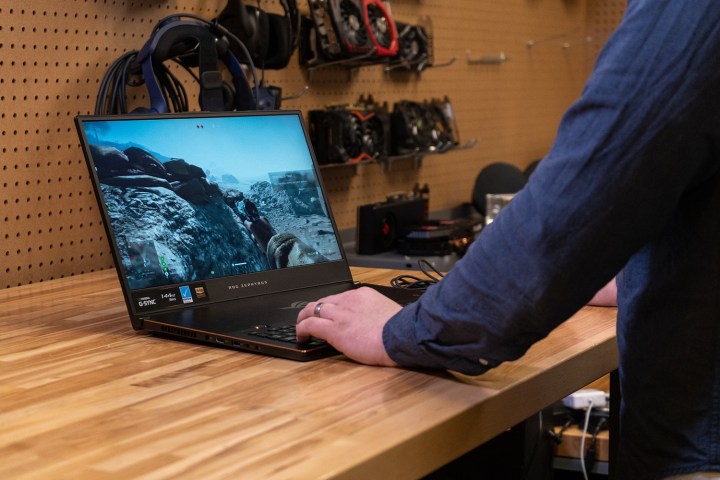
It wasn’t so long ago that gaming on a laptop was a sour experience. Gaming laptops were unwieldy, expensive, and non-upgradable. Even worse, performance wasn’t anywhere close to a desktop.
That story has changed in recent years, however, thanks to more powerful and efficient hardware like Nvidia’s new RTX 20-series hardware. Launching in 40 new gaming laptops this year, the new mobile card claims to further close the gap between the mobile and desktop PC gaming experience.
Does the new GPU push mobile gaming forward in a way you’ll notice? Or is it a marginal gain? We tested one of the first RTX 20-series
A new breed of mobile gaming
The Zephyrus

The Zephyrus isn’t the only thin gaming laptop. They’re everywhere you look, from the Razer Blade Advanced Model, the MSI GS65 Stealth, and others. Like a lot of these options, the Zephyrus GX701 has a 1080p 144Hz display to ensure smooth gameplay, 8GB of RAM (upgradable to 24GB), and the six-core Core i7-8750H processor.
That’s all well in good, but what’s new here is the RTX 2080 hardware. Let’s see how it performs in a laptop.
The fastest mobile GPU ever
Our first test of the RTX 2080 Max-Q was 3DMark. We ran the Time Spy, Fire Strike, and Sky Diver tests, all of which produced scores topping the performance of an unlocked GTX 1080 in the Alienware 17 R5, if only by a bit. But remember — the new Zephyrus is a tiny laptop by comparison.
It’s an impressive 30 percent increase over the 1070 Max-Q, which was the fast hardware most thin-and-light
How does it compare to its desktop RTX 2080 counterpart?
Not as well as we’d hoped. We saw approximately a 25 percent dip compared to an Asus desktop with a Core i9-9900K and an unlocked RTX 2080. That’s a bit disappointing. As usual, the new hardware came with promises that it would further reduce the gap between mobile and desktop gaming. Yet this Zephyrus suggests the gap remains significant. It’s possible other

Still, the specifications offer a reason for the reduction in speed. The Nvidia RTX 2080 Max-Q features the same amount of CUDA cores as the desktop RTX 2080 video card, as well as the same memory bandwidth.
A reduction in clock speed caught our attention, though. There’s a 50 percent decrease from the RTX 2080 to the RTX 2080 Max-Q, down from 1515 MHz to 735 MHz. The difference between the GTX 1080 and GTX 1080 Max-Q, by comparison, was 18 percent. But Nvidia says the factor that allows the RTX 2080 Max-Q to be squeezed into these tiny
What do the games say?
3DMark is just one test, though. Let’s get into some games.
We loaded up Battlefield V, Civilization VI, Fortnite, and Deus Ex: Mankind Divided, all games we expected the RTX 2080 Max-Q to play smoothly. We were glad to see that was the case, even at higher resolutions and with graphics settings cranked. Even Deus Ex, a notoriously poorly-optimized title, held us at 76 FPS (frames per second) at 1080p and Ultra. That’s 20 percent behind the desktop 2080, but a solid 30 percent faster than the Razer Blade with its 1070 Max-Q. It’s tied evenly with the GTX 1080 in the Alienware 17 R5.
We saw similar results in fast-paced shooters like Battlefield V and Fortnite, which is where the high refresh-rate panel became a must-have feature. With graphics turned up to Ultra in Battlefield V, the GX701 managed an average of 108 FPS. It hit 152 FPS when brought down to Medium. We haven’t tested this new game on older systems, but the environments felt immersive and the action was responsive. Meanwhile, the system played Fortnite with ease, pushing over 200 FPS with settings at Epic.
The Zephyrus even posted some fast framerates for Civilization VI. At 95 FPS with settings maxed, it’s the fastest system we’ve seen the game play on outside desktops with a 2080 or 2080 Ti. It didn’t have the lead in Battlefield 1 though. The Zephyrus averaged 113 FPS, while the full GTX 1080 featured in the Alienware 17 R5 beats it at 139 FPS. Still a healthy lead over the GTX 1070 Max-Q in the Razer Blade, which got us 84 FPS.
What about higher resolutions? The GX701 has only a Full HD display, but that doesn’t mean you’re limited to 1080p. We plugged in a

Can it do
The GPU never rose over 85 degrees Celsius during our tests. While parts of the aluminum became hot, the placement of the GX701’s keyboard means the areas your hands rest stay cool enough to touch for long periods of play.
Ray tracing, DLSS, and the future of gaming
While the new RTX hardware is great in
Still, the RTX 20-series for



